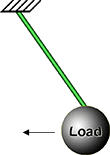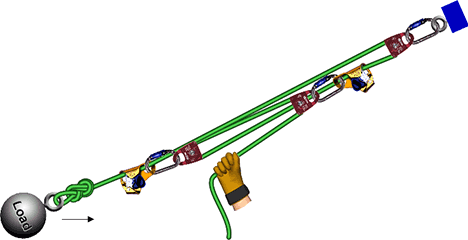
This also applies to cable, chain, and webbing.
Gear that is anchored includes anchors, rocks, trees, tripods, trucks, etc.
A "bight" is a simple loop in a rope that does not cross itself.
A "bend" is a knot that joins two ropes together. Bends can only be attached to the end of a rope.
A "hitch" is a type of knot that must be tied around another object.
"Descending devices" (e.g., ATCs, Brake Bar Racks, Figure 8s, Rescue 8s, etc) create friction as their primary purpose. The friction in descending devices is always considered when calculating forces.
The "Safety Factor" is the ratio between the gear's breaking strength and the maximum load applied to the gear (e.g., 5:1).
Calculating the forces on an infinite number of systems is a daunting task—both for a computer program and for an individual. This page explains a few of the situations where vRigger may not display the results you expect.
Choose a topic:
If the above links don't resolve your question, read how you can get help on force calculations. You can also learn more about rigging forces.
The vRigger engineers have gone to great lengths to see that vRigger calculates forces correctly, but some systems do not have a static solution and some that vRigger can't solve. See Incorrect Force Calculations for tips when the results don't look correct.
When the Consider Angles option is selected, vRigger will move gear side-to-side as it seeks a solution. For example, when considering rope angles, vRigger must move this load to the left because there are horizontal forces "pulling" the load to the left.

This next system might not be as obvious, but as with the above system, vRigger will move this load so it is directly below the anchor—that might not be what you were expecting.

Force information cannot be displayed unless the forces have been calculated. If you modify the system in any way, the forces will no longer be valid.
Force labels can be displayed near each piece of gear, in ScreenTips, and on the status bar. Learn more about displaying forces.
This message is displayed if it is taking longer than expected to calculate the forces. You have the option of canceling or continuing the calculations. You can stop the calculatiing at any time by pressing any key on your keyboard.
Sometimes vRigger is unable to calculate forces on highlines with multiple track lines and/or tag lines when the Consider Angles option is selected. In these systems, vRigger may repeatedly move gear side to side as it attempts to find a solution. You might try removing the tag lines or simplifying the system.
This message appears when the force on gear that can pull or release has exceeded its maximum force. Refer to the Maximum Force setting in the properties pane.
If you encounter a force calculation problem that you cannot resolve, or if vRigger is unable to correctly calculate the forces in your system, you can send the *.rig file to info@vRigger.com with a short note explaining the problem you encountered and any messages that were displayed. Like most people, we are constrained by time, but we'll try to look into it.
Learn about rope rescue physics and mechanical advantage at RopeRescueTraining.com.
Watch a video that explains how to calculate forces.
REMINDER: The force calculations in vRigger are calculated based on a static, two-dimensional computer screen—the values can vary in the "real world." It is your responsibility to understand the strength of your rigging systems.